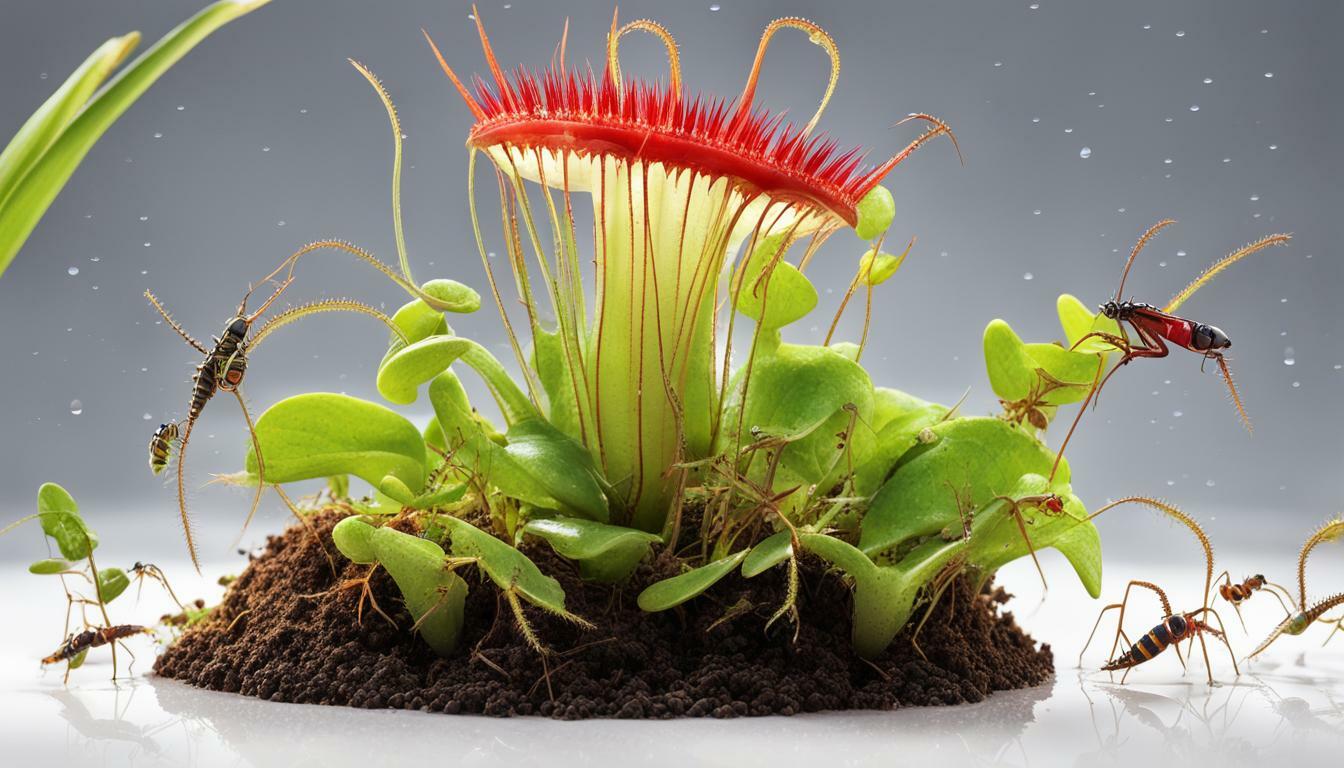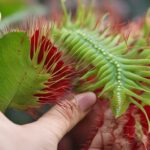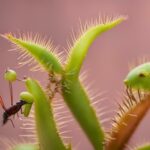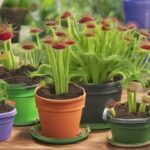If you’re looking to care for a Venus flytrap, it’s important to understand its unique survival requirements. These carnivorous plants have specific needs when it comes to their habitat, feeding, watering, sunlight, soil, temperature, humidity, and dormancy. By meeting these needs, you can ensure the healthy growth and long-term survival of your Venus flytrap.
Key Takeaways:
- The Venus flytrap requires specific care to survive.
- Understanding the plant’s habitat needs is critical for its health.
- Feeding the Venus flytrap requires attention to its carnivorous nature.
- Proper watering, sunlight, soil, temperature, humidity, and dormancy must be maintained.
Feeding the Venus Flytrap
The Venus flytrap is a carnivorous plant, and feeding it is paramount to its survival. Insects are the primary source of nutrients for the Venus flytrap, as they provide the necessary proteins that the plant requires to grow and thrive.
What types of insects can Venus flytraps consume?
Venus flytraps can consume a wide range of insects, including flies, ants, spiders, and even small grasshoppers. They have tiny hairs known as trigger hairs on the inside of their trap leaves, which prompt the trap to shut when the hairs are touched by an insect.
How often should you feed your Venus flytrap?
It’s important to remember that the Venus flytrap doesn’t need to be fed every day, and overfeeding can actually harm the plant. Feeding your Venus flytrap once a week or every two weeks is sufficient.
How do you feed your Venus flytrap?
When feeding your Venus flytrap, it’s essential to avoid triggering the trap accidentally. Use small, live insects, such as fruit flies or small spiders, and place them inside the open trap. Avoid touching the trigger hairs or the inside of the trap while feeding to prevent the trap from closing.
What happens if you don’t feed your Venus flytrap?
If your Venus flytrap doesn’t receive enough nutrients from insects, it will begin to use its own resources to survive. This can lead to the plant’s decline and eventual death if left untreated.
Feeding your Venus flytrap may seem daunting, but it’s a necessary part of caring for this fascinating plant. With proper feeding techniques and a balanced approach, your Venus flytrap will thrive and continue to capture insects for years to come.
Watering the Venus Flytrap
Proper watering is crucial for the survival of your Venus flytrap. The plant’s natural habitat is the damp, nutrient-poor soils of the southeastern United States. Venus flytraps have adapted to these conditions, and overwatering or underwatering can quickly kill your plant.
The most important thing to remember when watering your Venus flytrap is to keep its soil consistently moist but never waterlogged. This means you should water your plant whenever the top layer of soil feels dry to the touch, but avoid leaving it sitting in standing water.
When it comes to the type of water to use, always use distilled or rainwater. Venus flytraps are sensitive to minerals and salts found in tap water, which can accumulate in the soil over time and damage the plant’s root system.
Here are some important tips to keep in mind when watering your Venus flytrap:
- Water your plant from the bottom up by placing it in a tray or saucer of distilled or rainwater. This allows the roots to soak up water naturally without overwhelming the plant.
- Never let your Venus flytrap dry out completely or sit in standing water for long periods.
- Water more frequently in the summer months when the plant is actively growing and less often in the winter when it enters its dormant phase.
- If your Venus flytrap starts to wilt or its leaves turn brown and crispy, it may be a sign of overwatering or underwatering. Adjust your watering routine accordingly.
By following these watering guidelines, you can help your Venus flytrap thrive and grow healthy.
Providing sunlight for the Venus flytrap
The Venus flytrap requires ample sunlight to flourish, and providing it with the right amount is crucial for its health. In the wild, Venus flytraps grow in areas with full sun exposure, but they can also tolerate partial shade.
When growing Venus flytraps indoors, it’s essential to place them in a sunny spot, such as a south-facing window. They require at least four hours of direct sunlight daily, but too much direct sunlight can cause leaf burn, so shading may be necessary during the hottest hours of the day.
It’s important to avoid placing the plant behind a glass window, as it can reduce the amount of light the plant receives. You can use a sheer curtain to filter the light if needed.
During the winter months, when the sun is less intense, you may need to supplement your Venus flytrap’s sunlight with artificial lighting, such as fluorescent or LED lights. Place the lights about six inches above the plant and keep them on for 12-14 hours a day.
Remember that the Venus flytrap is a delicate plant, and excessive or inadequate sunlight can cause stress and damage. By providing your Venus flytrap with the right amount of sunlight, you can help it thrive and grow beautifully.
Choosing the right soil for the Venus flytrap
The Venus flytrap has very specific soil requirements that contribute to its overall health. To ensure your plant thrives, you need to choose the right soil.
The best soil for Venus flytraps is an acidic, nutrient-poor soil that is well-draining. A mixture of sphagnum moss and sand in a 1:1 ratio is ideal. Avoid using regular potting soil, which may contain too many nutrients that can harm your plant.
The pH level of the soil should be between 4.5 and 5.5. You can test the pH level with a soil test kit from your local garden center. If the pH level is too high, you can lower it by adding a small amount of sulfur to the soil.
Proper drainage is crucial for the Venus flytrap’s survival. Make sure the soil is airy and light, allowing water to flow through easily. You can achieve good drainage by adding perlite, sand, or vermiculite to the soil mix.
When repotting your Venus flytrap, be sure to choose a pot that is the right size. Avoid using a pot that is too large, as this can cause the soil to retain too much moisture, leading to root rot or fungal growth. A pot that is one to two inches wider than the plant is ideal.
Maintaining the Right Temperature and Humidity
Proper temperature and humidity are crucial for the growth and survival of your Venus flytrap. The ideal temperature range for these plants is between 70-85°F (21-29°C) during the day and 55-65°F (13-18°C) at night. Excessive heat or cold can cause stress and damage to your plant.
Venus flytraps also prefer a high level of humidity, between 50-60%. To maintain the appropriate level of humidity, you can place a tray of water near your plant, mist the leaves frequently, or use a humidifier. Avoid spraying the soil directly, as this can cause fungal growth and damage the roots.
It’s important to note that extreme temperature or humidity levels can be detrimental to your plant’s health. High temperatures above the recommended range can cause wilting or drooping, while low temperatures can cause your plant to enter into dormancy prematurely. High humidity, on the other hand, can cause fungal growth and other diseases.
To ensure that your Venus flytrap is thriving, monitor the temperature and humidity levels regularly. You can use a thermometer or hygrometer to measure the temperature and humidity respectively. Place the thermometer and hygrometer near your plant and record the readings at different times of the day and night.
Understanding Venus Flytrap Dormancy
As a Venus flytrap owner, it’s crucial to understand the process of dormancy that your plant will undergo. Dormancy is a natural phase that allows the plant to rest and conserve energy during the winter months. During this time, your Venus flytrap will stop growing and may even appear to die, but this is a normal and necessary process.
The dormancy period typically lasts from November to February, and during this time, you must adjust your care routine accordingly. To prepare your plant for dormancy, reduce the amount of light, water, and feeding gradually. By the end of October, begin to provide only minimal watering and feeding, and move your plant to a cooler location, ideally between 35 and 45 degrees Fahrenheit.
During dormancy, it’s essential to avoid disturbing the plant as much as possible. Do not fertilize or repot your plant during this period, as it needs time to rest and rejuvenate. You can, however, mist the leaves occasionally to maintain moisture levels. If you notice any dead foliage, remove it promptly to prevent rotting and fungal growth.
Once the dormancy period is over, and spring arrives, your Venus flytrap will emerge from its dormant state and begin to grow again. Increase the amount of light, water, and feeding gradually, and repot your plant if necessary. By providing the right environment during dormancy, you can ensure the healthy growth and long-term survival of your Venus flytrap.
Conclusion
By properly caring for your Venus flytrap, you can ensure its longevity and health. Understanding the plant’s specific requirements for feeding, watering, sunlight, soil, temperature, humidity, and dormancy is crucial for its survival. Remember that the Venus flytrap is a carnivorous plant that needs insects to meet its nutritional needs, and that it requires particular soil composition, pH levels, and drainage for healthy growth. Adequate watering, optimal sunlight exposure, and maintaining the right temperature and humidity levels are also essential. Finally, be prepared for your Venus flytrap’s dormancy period and provide the necessary care during this time. By following these guidelines, your Venus flytrap will thrive and remain a unique addition to your plant collection.
How Does Propagation Help Venus Flytraps Survive and Thrive?
The effective propagation of venus flytraps plays a crucial role in their survival and thriving. These carnivorous plants rely on propagation to produce offspring and expand their population. By spreading their seeds through mechanisms like wind dispersal, Venus flytraps ensure the continuation of their species. Successful propagation also allows them to adapt to different environments and take advantage of new opportunities for growth and sustenance.
FAQ
Q: What does the Venus flytrap need to survive?
A: The Venus flytrap needs the right care and specific habitat conditions to survive.
Q: How often should I feed my Venus flytrap?
A: Venus flytraps should be fed small insects every 1-2 weeks.
Q: What should I feed my Venus flytrap?
A: Venus flytraps can consume small insects like flies, ants, and spiders.
Q: How much water does a Venus flytrap need?
A: Venus flytraps require a moist environment. Water them with distilled or rainwater, keeping the soil damp at all times.
Q: How much sunlight does a Venus flytrap need?
A: Venus flytraps need at least 4-6 hours of direct sunlight daily. Avoid excessive or inadequate light exposure.
Q: What type of soil should I use for my Venus flytrap?
A: Use a mixture of peat moss and sand to create well-draining, acidic soil for your Venus flytrap.
Q: What temperature and humidity levels are ideal for Venus flytraps?
A: Venus flytraps prefer temperatures between 70-85°F (21-29°C) and humidity levels around 50-60%.
Q: Does a Venus flytrap undergo dormancy?
A: Yes, Venus flytraps go through a period of dormancy during the winter months. Provide appropriate care during this time.
Q: How can I prepare my Venus flytrap for dormancy?
A: Gradually reduce watering and place the plant in a cool location with less sunlight to prepare for dormancy.
Q: Is the Venus flytrap hard to care for?
A: While the Venus flytrap has specific needs, with proper care and attention, it can thrive in the right conditions.










